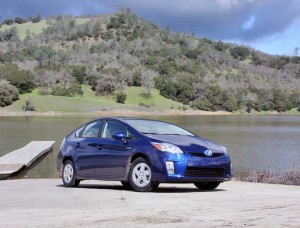It may be the world’s most popular hybrid-electric vehicle but that isn’t stopping Toyota from tinkering with success.
According to various reports, the fifth-generation Toyota Prius now in the midst of its development will be given a significantly updated design, a new platform – and a new all-wheel-drive version of the familiar Hybrid Synergy Drive system.
With more and more hybrids coming to market from virtually every major manufacturer Toyota appears not to want to wait until the competition catches up but hopes to continues to setting a benchmark for the gas-electric segment.
“The next Prius will redefine the hybrid as we know it,” the British publication Auto Express quotes a senior Toyota engineer promising.
It appears virtually every aspect of the Prius design and technology has been under review. Significantly, the new model will migrate to Toyota’s new C platform, in part to improve economies of scale. That new architecture will have the added advantage of slicing about 154 pounds from the vehicle’s weight – no insignificant amount considering every 100 pounds in mass is generally considered to be worth about one mile per gallon.
Add other improvements and the magazine cites a projected fuel economy number of 90 mpg – about 25% better than the current model. As the British gallon is larger than ours, that would likely work out to something closer to 72 mpg here, though there are often major gaps between the fuel efficiency numbers indicated by European versus American testing standards.
According to the Toyota engineer, the maker will adopt a new e-AWD, or electric All-Wheel-Drive system. As before, the primary CVT-like transmission will pump power to the front wheels, but the rear axle will draw power from an additional electric motor that “will operate at up to 37 mph.”
The overall Hybrid Synergy Drive system will undergo a number of modifications, including the downsizing of its power electronics. However, Toyota will maintain the familiar Nickel-Metal Hydride battery pack in the standard hybrid, even though the new Prius Plug-In has adopted lithium-ion power. Apparently, the maker feels it has made enough progress in terms of cost, size and reliability to hold onto nickel batteries even as competitors like Honda rapidly migrate to lithium technology.
(The new 2013 Honda CR-Z will adopt a lithium-ion battery to improve performance and mileage. Click Here for that report.)
Several sources have indicated the 2015 update of the Toyota Prius will see the most significant styling update since the first-generation hybrid appeared more than a dozen years ago.
“There’s an undercurrent among most people that they’re ready for a new Prius look,” Chris Hostetter, Toyota’s U.S. group vice president for strategic planning, recently told TheDetroitnews. The final shape hasn’t been locked in sheet metal, he cautioned, though “one of the avenues we’re exploring right now is to evolve it, and the other is to really evolve it.”
Toyota has long erred towards the conservative side, especially when it comes to design. But that is rapidly changing under a mandate from President Akio Toyoda to add more “passion” to the brand. The new Toyota Avalon is perhaps the first clear example of this new approach.
The counter-argument is the success of the current Prius, global sales hitting an all-time record and generating a sales increase of 60% year-over-year. It remains to be seen how much Toyota is willing to risk that success to remain ahead of the competition.

